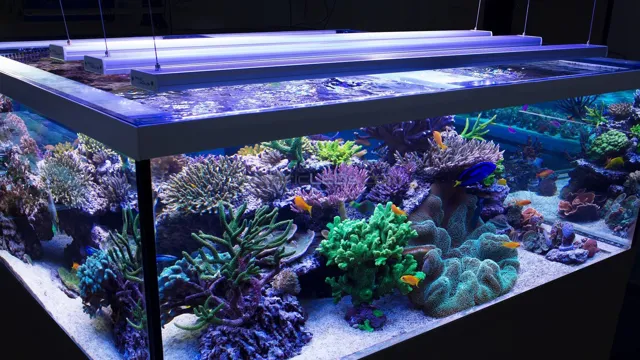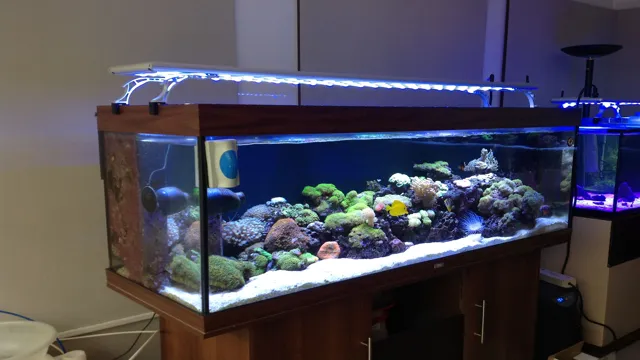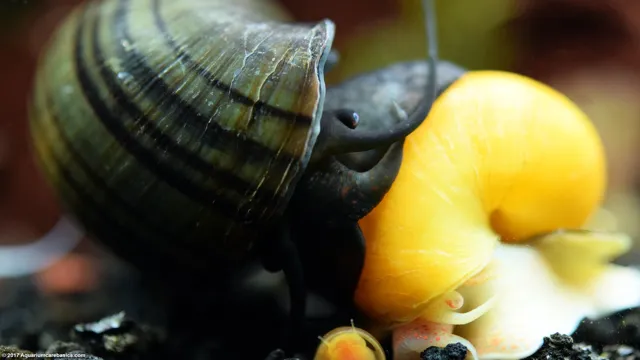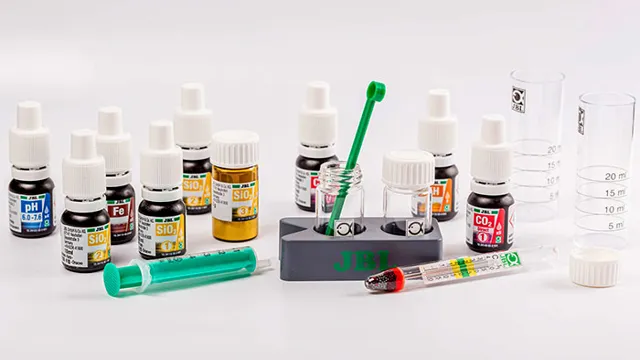If you’re an aquarium enthusiast, you know that having the right lighting is crucial for the health and happiness of your fish and plants. However, selecting the right aquarium lights can be overwhelming with so many options on the market. That’s where designing your own aquarium lights comes in.
Not only can it save you money, but it also gives you complete control over the lighting spectrum and intensity. In this blog post, we’ll explore the basics of designing aquarium lights, including the different types of light bulbs, how to calculate the correct wattage, and the benefits of using LED lights. So, whether you’re a seasoned aquarist or just starting, let’s dive into the world of designing your own aquarium lights.
Understanding Lighting Needs
Designing aquarium lights is a crucial step in creating a thriving aquatic environment. To achieve optimal lighting needs, you have to consider the type of aquarium, the plants, the fish species, and the lighting duration. For planted aquariums, you want to choose LED lights with a color temperature between 5000 K and 7000 K to provide adequate light for photosynthesis.
You can also add blue and red LED bulbs to encourage plant growth and coloration. For reef aquariums, you’ll need to select lights with a higher color temperature, usually in the range of 10000 K and above, to support the growth of corals and other invertebrates. In addition to selecting the right type of lighting, the duration and intensity of the light should be tailored to match your specific tank and its inhabitants.
Providing too much or too little light can negatively impact the health of your plants and animals. By taking the time to understand your aquarium’s lighting needs, you can design a lighting system that promotes a thriving aquatic ecosystem.
Types of Aquariums
As you set up your aquarium, it’s important to consider the lighting needs of your aquatic inhabitants. Different types of aquariums will have varying lighting requirements, based on the plants and fish you plan to keep. For example, a planted aquarium will require more intense lighting than a fish-only tank.
You’ll also need to pay attention to the color spectrum of your lighting, as different light wavelengths can affect how your fish and plants appear and grow. LED lights have become increasingly popular among aquarium hobbyists due to their low energy consumption and customizable settings. Ultimately, the key to successful aquarium lighting is finding the right balance for your specific setup and inhabitants.

Lighting Requirements for Various Fish
When setting up an aquarium, it’s important to understand the lighting needs of your fish. All fish have different requirements, and providing appropriate lighting can impact their overall health and behavior. For instance, species that originate from dimly-lit environments, such as cardinal tetras, benefit from subdued lighting that mimics their natural habitat.
On the other hand, fish that come from brightly-lit habitats, such as African cichlids, require ample lighting to thrive. LED lighting is becoming increasingly popular among aquarists as it offers a range of color spectrums and is energy-efficient. Overall, understanding your fish’s inherent lighting needs can help you create a thriving aquarium ecosystem.
Types of Aquarium Lighting Systems
Designing the perfect lighting system for your aquarium can be a daunting task, but understanding the different types of lighting systems available can make the process much easier. There are several types of lighting systems to choose from, including fluorescent, LED, and metal halide. Fluorescent lighting is a popular choice for aquariums because it is affordable and provides a wide range of colors.
LED lighting is another popular option, as it is highly energy efficient and can produce a spectrum of colors that mimic natural sunlight. Metal halide lighting, on the other hand, is best suited for larger aquariums, as it can be expensive and produce high levels of heat. When designing your aquarium lighting system, consider the type of aquatic plants and animals you plan to keep, as well as how much light they require.
Additionally, make sure to select a system that fits your budget and energy consumption needs. With the right lighting system, your aquarium can be a beautiful and thriving ecosystem for all its inhabitants.
Fluorescent Lighting
When it comes to setting up an aquarium, selecting the right lighting system is essential to keep your aquatic pets healthy and happy. Among the various lighting options available, fluorescent lighting is a popular choice for aquarium enthusiasts. Fluorescent bulbs are designed to emit bright, even light that can promote plant growth and enhance the colors of your fish.
There are two types of fluorescent bulbs to choose from, compact fluorescent and tube fluorescent. Compact fluorescent bulbs are small in size and offer greater flexibility for placement inside the tank. They are energy-efficient and come in a range of color temperatures to mimic natural lighting conditions.
Tube fluorescent bulbs, on the other hand, are long and narrow and are often suspended above the aquarium. They provide uniform light distribution and are ideal for larger tanks. When selecting the type of fluorescent lighting for your aquarium, consider the size of the tank and the types of plants and fish you have.
With the right type of fluorescent lighting, you can create a stunning underwater world that will be the pride and joy of any aquarium enthusiast.
LED Lighting
LED lighting has become quite popular in the aquarium industry due to its energy efficiency and low heat output. There are several types of LED lighting systems that are suited for different types of aquariums. Firstly, the Full Spectrum LED lighting systems can be used in a variety of aquariums and are perfect for plant growth.
Secondly, Color Enhancing LED lighting systems provide bright and vibrant colors to make the fish and corals stand out. They are perfect for saltwater aquariums. Thirdly, Actinic LED lighting systems emits blue light which mimics the underwater environment, and is perfect for promoting coral growth in reef aquariums. (See Also: How Often Should You Change Water in a Tropical Aquarium: Expert Tips)
Lastly, there are Moonlight LED lighting systems which emit a dim and calming blue light, perfect for simulating the moonlight in natural environments and are great for observing nocturnal fish and invertebrates. No matter what type of aquarium you have and what your lighting needs are, there is bound to be an LED lighting system that suits your needs. But remember, always do your research and ensure you are providing your aquarium with the appropriate lighting it needs to thrive.
Halogen Lighting
Halogen Lighting When it comes to aquarium lighting systems, there are various options to choose from. One of the most popular types of lighting is halogen lighting. Halogen bulbs are known for their bright and intense light, making them perfect for aquariums with live plants.
Halogen bulbs also emit a warm, yellowish light that can bring out the colors of your fish and corals. Halogen lighting is available in various wattages and sizes, depending on the size of your aquarium. Additionally, halogen bulbs are relatively affordable compared to other types of aquarium lighting, making them a popular choice for many aquarium enthusiasts.
One of the main benefits of halogen lighting is its energy efficiency. Halogen bulbs consume less energy than incandescent bulbs while providing the same level of brightness. Additionally, halogen bulbs have a longer lifespan than incandescent bulbs, making them a more cost-effective option in the long run.
Overall, halogen lighting is a great choice for aquariums with live plants or for showcasing the natural colors of your fish and corals. With its energy efficiency and long lifespan, halogen bulbs provide an affordable and reliable lighting solution for any aquarium enthusiast.
Calculating Light Requirements
If you’re interested in keeping aquatic plants or coral in your aquarium, designing the right lighting system is essential. The amount of light your aquarium needs is determined by the type of plant or coral you have, as well as the size of your aquarium. To calculate the amount of light your aquarium needs, you’ll need to determine the wattage or LED intensity required for the species of plants or coral you have.
This calculation is usually based on the photosynthetic needs of the organism. Once you have this information, you can choose the right type of light source and adjust the duration and intensity of the lighting accordingly. This will help you create a healthy environment for your aquatic plants or coral to thrive in and enhance the natural beauty of your aquarium.
With the right lighting, you’ll be able to enjoy the vibrant colors and growth of your aquatic species for years to come.
Determining Wattage Needs
Calculating the wattage needed to illuminate a space can be a daunting task for those new to the world of lighting. However, there are some simple steps you can follow to get an accurate estimate of the wattage you’ll need to light your space effectively. The first step is to determine the size of the room in square footage.
Once you have this measurement, you can use it to find the appropriate number of lumens needed to light the space. A good rule of thumb is to aim for at least 20 lumens per square foot. From there, you can calculate the total wattage needed by dividing the total lumen requirement by the efficiency of the bulbs you plan to use.
For example, if you need 2000 lumens to light a room, and your bulbs have an efficiency of 80 lumens per watt, you would need 25 watts of electricity to light the space effectively. By taking the time to accurately calculate your wattage needs, you can ensure that your lighting is both effective and energy-efficient.
Calculating Lumens per Gallon
When it comes to setting up an aquarium, one of the most important things to consider is the lighting. But how do you calculate the right amount of light for your tank? One method is to use lumens per gallon. Lumens measure the amount of visible light emitted by a light source.
Gallons measure the volume of water in your aquarium. The appropriate levels of lumens per gallon depend on the types of plants and fish in your tank. Generally, a range of 20-40 lumens per gallon is suitable for low-light plants and fish, while high-light plants may require up to 60 lumens per gallon.
It’s important to note that too much light can also be harmful, as it can promote algae growth and stress out your fish. It’s all about finding the right balance and consulting with a professional if needed. By calculating the lumens per gallon for your tank, you can ensure that your aquarium has the proper amount of light for your aquatic friends.
Choosing Light Fixtures and Bulbs
When designing your aquarium lighting, it’s important to consider not only the aesthetic you want to achieve but also the needs of your fish and plants. One of the first decisions you’ll need to make is what type of light fixture to use. LED lights are popular because they’re energy-efficient and produce less heat than other types of bulbs.
However, fluorescent bulbs are also a good choice because they provide a wider spectrum of light. Once you’ve chosen your fixture, it’s important to select the right bulbs. Different types of fish and plants require different levels of light intensity and spectrums, so be sure to read up on their specific needs.
Additionally, it’s important to choose bulbs that are the right size and wattage for your fixture. With a little bit of research and careful consideration, you can design aquarium lights that not only look great but also promote the health and growth of your aquatic inhabitants. (See Also: How to Prevent Plant Shock in Aquarium: Tips and Tricks)
Fixture Styles and Mounting Options
When it comes to lighting fixtures, there are many styles and mounting options to choose from. The style of a fixture can greatly impact the ambiance of a room and choosing the right one is important. Some popular styles include modern, traditional, rustic, and industrial.
Mounting options include ceiling mount, wall mount, and pendant mount. It is important to consider the space and purpose of the room when choosing a mounting option. For example, a wall-mounted fixture may be more appropriate in a hallway, while a pendant mount may work best over a dining table.
It is also important to choose the right bulb for your fixtures to achieve the desired lighting effects. LED bulbs are a popular choice because of their energy efficiency and long lifespan. When selecting a bulb, consider the color temperature and brightness.
A warm white bulb will provide a cozy atmosphere while a cool white bulb will create a more modern and sleek look. Choosing the right fixtures and bulbs can make a big difference in the look and feel of your home.
Choosing the Right Bulbs
When it comes to choosing light fixtures and bulbs, there are a few key things to consider to ensure you get the right lighting for your space. First and foremost, think about the purpose of the room and how much light it needs. A workspace will require brighter light bulbs than a bedroom or living room.
Next, think about the type of fixture you want. Do you need a ceiling light, floor lamp, or table lamp? The size and style of your fixture will vary depending on the space and your personal taste. Once you’ve chosen your fixture, it’s time to choose the right bulbs.
LED bulbs are a popular choice because they’re energy-efficient and long-lasting. However, if you prefer the warm glow of incandescent bulbs, choose a lower wattage to save on energy costs. And finally, don’t forget to pay attention to the color temperature of your bulbs.
Warmer temperatures (around 2700K) are ideal for creating a cozy atmosphere, while cooler temperatures (around 5000K) are better for task lighting. By taking these factors into account, you’ll be well on your way to choosing the perfect fixtures and bulbs for your home.
Installation and Maintenance Tips
Designing aquarium lights requires attention to detail and proper planning. To start, consider the size and shape of your tank, as well as the type of fish and plants you have. LED lights are a great option for aquariums as they provide energy-efficient and customizable lighting.
When selecting LED lights, consider the color temperature and intensity to ensure your aquatic ecosystem thrives. It’s also important to have timers set up for consistent and appropriate lighting cycles. To maintain the lighting, clean the fixtures regularly and replace any burnt-out bulbs promptly.
With the right design and maintenance, your aquarium will have the perfect lighting to showcase the beauty of your underwater world for years to come.
Proper Placement and Arrangement
Proper Placement and Arrangement When installing a new HVAC unit, the placement and arrangement of the equipment are crucial for optimal functionality. In outdoor installations, you must ensure that the condenser unit is placed in a location where there is free airflow and no obstructions that could hinder its performance. It is also essential to avoid placing the unit near trees or bushes, which could clog the condenser coils with debris and reduce its efficiency.
Furthermore, indoor units must be located in areas where there is sufficient ventilation and adequate space for the unit to operate correctly. Furthermore, proper maintenance of the HVAC system will help to maintain its efficiency, prolong its lifespan, and keep it in top working condition. Regular cleaning of the air filters will help to promote clean indoor air quality and ensure that the system is running efficiently.
At the same time, it is important to have the unit regularly serviced by a professional HVAC technician to keep it in optimal condition and reduce the likelihood of mechanical failures. Taking care of your HVAC system through proper installation, placement, and regular maintenance is essential for its optimal performance, energy efficiency, and longevity.
Cleaning and Replacing Bulbs
Cleaning and replacing bulbs are essential steps in maintaining a well-lit and comfortable living space. Firstly, it’s important to turn off the power supply before starting the cleaning or replacement process. For cleaning bulbs, a soft, dry cloth can be used to gently wipe away dirt and grime.
More stubborn stains can be tackled using a damp cloth or a mild cleaning solution, but care should be taken not to get any liquid into the bulb’s electrical connections or the socket. When replacing bulbs, it’s important to choose the correct wattage and style for the fixture – matching the wrong type of bulb can lead to reduced light output and potential fire hazards. Additionally, it’s worth considering upgrading to energy-efficient bulbs, like LEDs, which can save money on energy bills over time. (See Also: How to Decorate Goldfish Aquarium: A Comprehensive Guide for Beginners)
Regular maintenance of bulbs can help to extend their lifespan and keep your home well-lit and comfortable for years to come.
Adjusting Light Levels for Optimal Growth
Adjusting light levels is a critical factor in ensuring optimal growth for your indoor plants. Here are some installation and maintenance tips to help you achieve the best possible results. When installing your lights, consider the height and positioning of your plants, as well as the intensity of the light source.
Adjust the light levels according to the growth stage of your plants. For example, during the vegetative stage, your plants need higher levels of blue light, whereas in the flowering stage, they require more red light. It’s essential to monitor your plants’ growth regularly and adjust the light levels accordingly.
Beyond installation, maintenance is also key. Keep your light bulbs clean, as dirt and dust can reduce light output. Finally, replace your bulbs regularly, as they degrade over time and may not provide the necessary light levels for optimal growth.
Remember that adjusting light levels is an ongoing process that requires knowledge and attention to detail. With these tips, you’ll be on your way to achieving healthy and thriving indoor plants.
Conclusion
In conclusion, designing aquarium lights is an art and science that requires attention to detail, creativity, and a sincere passion for aquatic life. The key is to strike the right balance between aesthetics and functionality, understanding the needs and preferences of your aquatic creatures, and using cutting-edge technology to create a unique and immersive environment. So, whether you’re a seasoned hobbyist or a curious first-timer, always remember to keep your tank well-lit, experiment with different colors and intensity levels, and most importantly, have fun while you’re at it.
With these tips and tricks in mind, you’re sure to make a splash and create an aquarium that will leave everyone in awe!
FAQs
What are the benefits of designing aquarium lights?
Designing aquarium lights provides essential light and energy to aquatic plants and animals, promotes healthy growth, and enhances the aesthetic appeal of the aquarium.
How do you determine the appropriate amount of light for your aquarium?
The appropriate amount of light for your aquarium varies depending on the type of plants and animals in your aquarium. Generally, aquariums require 12-14 hours of light per day. Consult with a professional or do research to determine the best lighting plan for your aquarium.
What are the types of lighting fixtures used in aquariums?
There are three main types of lighting fixtures used in aquariums: fluorescent, compact fluorescent, and LED. Each type has its own advantages and disadvantages, so research the best option for your specific aquarium.
How does the color temperature of the lighting affect the fish and plants in the aquarium?
The color temperature of the lighting affects the appearance of the aquarium and the behavior of the fish and plants. Blue lighting can enhance the color of fish and promote plant growth, while warm colors like red and yellow can stimulate the breeding processes of certain fish.
Can aquarium lights be used for both saltwater and freshwater aquariums?
Yes, aquarium lights can be used for both saltwater and freshwater aquariums. However, the specific type of lighting and the amount of light needed may vary depending on the type of aquarium.
How often should aquarium lights be replaced?
Aquarium lights should be replaced every 6-12 months, as the brightness and effectiveness of the light will decrease over time.
Are there any safety concerns when designing aquarium lights?
Yes, safety concerns include electrical shock, heat damage to the aquarium, and fire hazard. It is important to consult with a professional and follow proper safety guidelines when designing aquarium lights.







